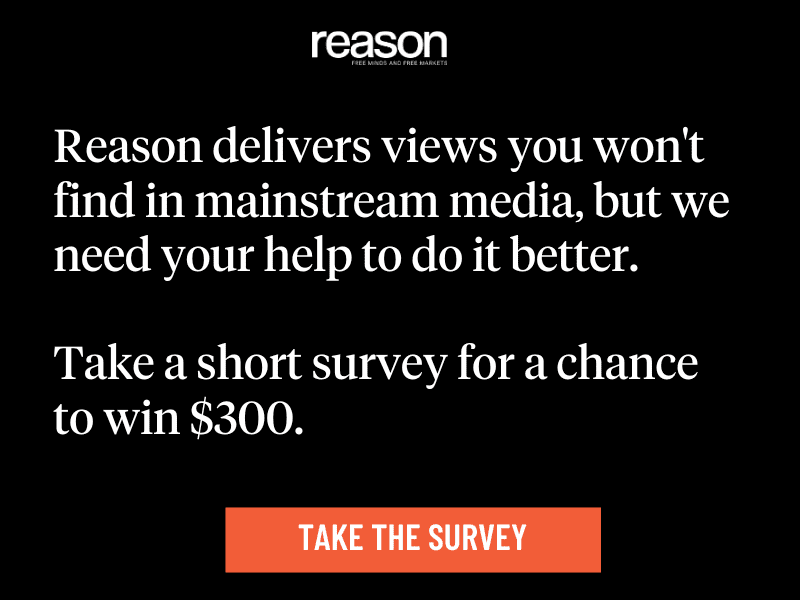I Left Florida To Try Lab-Grown Meat
When Florida Gov. Ron DeSantis banned cultivated meat, Reason's Zach Weissmueller visited California labs to try cultivated chicken and salmon and explore the future of this industry.
HD DownloadA company based in San Francisco just became the first in the world to sell direct to consumers what its founders call "cultivated meat," meaning it didn't originate from an animal that lived on a farm or in a muddy feedlot but from a giant steel vat.
The first thing I wanted to know—is it delicious? I visited one of the labs of GOOD Meat to taste it for myself.
GOOD Meat, a subsidiary of the company Eat Just, began selling its lab-grown chicken direct-to-consumers in Singapore this past summer and recently received approval from the Food and Drug Administration, which means that it could be coming to a grocery store or restaurant near you.
Except if, like me, you live in the Sunshine State.
"Take your fake lab-grown meat elsewhere. We're not doing that in the state of Florida," declared Florida Gov. Ron DeSantis when he banned lab-grown meat last May, claiming that it's part of a left-wing conspiracy orchestrated by the World Economic Forum (WEF). Alabama followed in Florida's footsteps with its own ban.
"This is really a vision of imposing restrictions on freedoms for everyday people while these elites are effectively pulling the strings, calling the shots, and doing whatever the hell they want to do in their own lives," said DeSantis. "These folks at, like, the World Economic Forum and Davos, they meet and they scheme. Those policies are dead on arrival in the state of Florida."
Founded by Klaus Schwab and host of the famous annual Davos conference, the WEF has, in fact, endorsed lab-grown meat for its potential to reduce the environmental impact of raising animals. But Josh Tetrick, Eat Just's founder and CEO, says DeSantis' rhetoric is nonsensical.
"It's an easy way to sort of establish your anti-woke credibility, by saying that you're against anything that the global elites in the World Economic Forum want to do," says Tetrick, who says he has no connections to the WEF. "My [agenda] is not an authoritarian agenda. It's simply to build a company and try to do some good stuff for the food system."
Dean Black, a Republican member of the Florida House of Representatives, was instrumental in the passage of the bill banning lab-grown meat in Florida. He disagrees with Tetrick's assertion that cultivated meat is likely to improve the food system. I visited him at his Jacksonville residence, which, it turns out, is a cattle ranch.
"My family have been raising beef cattle in Florida since 1803," says Black. "So you might say it's in my roots. It's in my blood. And…lab-grown meat, that's not meat."
Nearly half of Florida's agricultural land is used for beef cattle. The Florida Cattlemen's Association lobbied for the lab-grown meat ban, and its leadership attended DeSantis' signing of the bill.
But Black maintains that the law is about safety, not protecting an entrenched industry from competition.
"I don't think ranchers like myself have a lot to fear from consumers choosing the cellular-based nitrogen protein paste over my steak. I just don't see that as a big threat," says Black. "My concern as a legislator is about public safety."
The FDA has been studying the safety of cultivated meat since the industry began developing this technology about a decade ago and has found no evidence of toxic byproducts. In reviewing and approving the applications of Good Meat and its competitor Upside Foods, it's endorsed the industry's findings that the products are "as safe as comparable foods produced by other methods."
But Black isn't buying it.
"There was a time when the government said smoking cigarettes was good for you. And we now know differently. The federal government is not God. And we're going to err on the side of safety," says Black.
A specific concern of the critics of cultivated meat is a process known as "cell immortalization." GOOD Meat makes its chicken by sampling real tissue and then selecting cells that continue dividing indefinitely, which critics equate with cancer.
"We have no idea what the long-term effects…are of consuming cells that are found in cancer," said one of the bill's authors during the debate.
"After a really rigorous, two-and-a-half-plus year review, both the FDA and the regulators in Singapore, both really well respected, said it is safe for human consumption," says Tetrick when asked about immortalization.
The FDA, in reviewing the immortalization technique in cultivated chicken, said that the cells would "quickly die" once removed from the bioreactors feeding their growth and that cooking and digestion would further break them down.
"In summary, we did not identify any properties of the cells as described that would render them different from other animal cells with respect to safety for food use," wrote the agency.
"I will simply offer that the science isn't settled yet," says Black. "They have work to do. They best get to work. And one hopes that when they get that work done, that we'll know it when we see it."
Tetrick says that critics of cultivated meat underplay the valid health concerns about factory farming that their product aims to ameliorate. Overuse of antibiotics in factory farming is making bacteria more resistant to treatment, a problem that causes tens of thousands of unnecessary deaths annually in the U.S. alone. And 48 million Americans get sick from foodborne illnesses every year. Tetrick says large-scale factory farming is exactly what he hopes to replace one day, not the romanticized open American pasture.
"I think they'll probably always be a place for pasture-raised, more ethical meat," says Tetrick. "We wouldn't be doing this if that's what the meat industry actually looked like. I don't think any American is concerned about losing a dark, automated warehouse that smells like urine."
Instead of a crowded slaughterhouse, cultivated meat begins in sterile labs. And it grows in giant stainless steel vats before being shaped into patties and cutlets. Meat provides about a quarter of global protein consumption, and that's expected to grow substantially as the world grows wealthier.
Aryé Elfenbein, who is the founder of Wildtype, says his industry can help meet this demand. Wildtype makes salmon in a lab.
"This is about taking the pressure off the oceans that have been overfished now," says Elfenbein.
The United Nations estimates that a third of the world's fish stocks are overexploited. With demand for fish expected to double in the next 25 years, Elfenbein thinks Wildtype can help.
However, cultivated meat still faces significant production challenges. For one, it's not easy to duplicate the nutritional profile of conventional meat. Elfenbein believes this will be solved as the product is refined.
"When it comes to fats and, in particular, the more, helpful fats, like the omega-3s, omega-6s, it is at the same level as the most pristine wild-caught Pacific salmon," says Elfenbein. "The protein level is still below what it would be in conventional salmon, but that's something that in future iterations of what we're creating, will be at exactly the same level."
Skeptics like Black believe the lab is unlikely to duplicate what the pasture can produce.
"It's not even close," says Black. "There are bioactive constituents of beef that we're still discovering. We know that there are omega-3s and carotenoids and flavonoids…and just numerous other bioactive compounds that come from the diet that the animals eat."
Elfenbein says a fair evaluation of the tradeoffs would also take into account all of the harmful substances that you won't find in cultivated meat, which is missing many of the noxious substances in farm-raised and wild-caught animals.
"We still are learning about nutrition generally. Things that we do know are that mercury is toxic, that arsenic is toxic, that antibiotics are not great for many, many reasons, that microplastics are becoming increasingly pervasive in our seafood system," says Elfenbein. "And so the absence of those, I think, is actually a greater health benefit than any of the types of things that [Black] is describing."
But Black and the cattle ranchers, poultrymen, and salmon farmers might not have much to worry about in the short-term anyway, because none of these companies have figured out a way to bring production even close to where they can turn a profit. GOOD Meat's chicken nuggets are on sale in Singapore, but they contain only 3 percent cultivated meat to stay competitive. In other words, 97 percent of what they're selling today is plant-based filler.
"One of the big challenges is how do you reduce the costs of the feed? And the feed is amino acids and sugars and salt," says Tetrick. "Maintaining a sterility at a larger scale is a big technical challenge. So if we and other companies aren't able to figure that out, you know, then we're screwed. And probably the single biggest challenge is these facilities are just too damn expensive. I don't know, a large-scale cultivation meat facility, would be north of half $1 billion to build. And it's just way too much."
Cultivated meat has a ways to go before it can come close to satisfying global meat consumption. But, whether it's really just "nitrogen paste" or not, a majority of American consumers are open to trying it—60 percent of meat eaters say they're willing. The question is, will governments let them?
"The consumers should be able to decide what they want to eat," says Elfenbein. "That should determine whether or not this company succeeds or fails, not politicians opining about food safety."
Photo Credits: Billy Hathorn, CC BY-SA 3.0, via Wikimedia Commons; Lian Yi / Xinhua News Agency/Newscom; Benedikt von Loebell / Avalon/Newscom; JASPER JACOBS/Belga/Sipa USA/Newscom; Nikhinson Julia/ABACA/Newscom; Gage Skidmore/ZUMAPRESS/Newscom; Annabelle Gordon/picture alliance / Consolidated News Photos/NewscomCHINE NOUVELLE/SIPA/Newscom; Avalon/Newscom; Alexander Pohl/Sipa USA/Newscom; World Economic Forum/Sandra Blaser / Avalon/Newscom; Gary Coronado/ZUMAPRESS/Newscom; Deans/ZUMApress/Newscom; Paul Hennessy/ZUMAPRESS/Newscom; Pedro Portal/TNS/Newscom; Joe Burbank/TNS/Newscom; Bayne Stanley/ZUMA Press/Newscom; Loren Holmes / Adn/ZUMA Press/Newscom; Richard Graulich/ZUMAPRESS/Newscom; Keith Myers/MCT/Newscom; Bkirkland909, CC BY-SA 3.0, via Wikimedia Commons; Envato Elements; Artlist.io.
Music Credits: "Dawn - Instrumental Version," by nuer self via Artlist; "Sunset," by nuer self via Artlist; "Bubbles Drop," by Cosmonkey via Artlist; "Life's Journey Begins," by Pitched Percussion via Artlist; "Dive," by Stanley Gurvich via Artlist.
- Editor: Regan Taylor
- Camera: Justin Zuckerman
- Color Correction: Cody Huff
- Audio Production: Ian Keyser
- Camera: James Marsh




Show Comments (94)